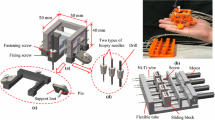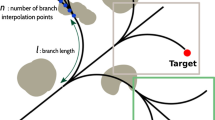Abstract
This paper introduces a novel intervention planning methodology facilitating the use of a parallel manipulator (Hexapod) in a robotic skull-base surgery (“SBS”) system. This safety intensive procedure requires a cavity to be created in the skull-base so as to allow access to deep-seated brain areas that are inaccessible by other routes. An image-guided system (presenting 3-D information) allows the surgeon to pre-operatively define the features that are to be avoided. Although the Hexapod used has good positioning accuracy and high stiffness, its workspace suffers from some undesirable characteristics. A novel technique has been developed to alleviate this problem by means of segregating the task-envelope (i.e. the cavity in the skull-base) and Hexapod workspace generation process. The placement of the task-envelope within the reachable workspace of the Hexapod is planned in a virtual world. This “placement” is then replicated in the physical world by the use of a dexterous base robot supporting the Hexapod. This ensures that the region encapsulated by the task-envelope encapsulated is fully reachable by the Hexapod.
Chapter PDF
Similar content being viewed by others
Keywords
These keywords were added by machine and not by the authors. This process is experimental and the keywords may be updated as the learning algorithm improves.
Author information
Authors and Affiliations
Editor information
Editors and Affiliations
Rights and permissions
Copyright information
© 2001 Springer-Verlag Berlin Heidelberg
About this paper
Cite this paper
Sim, C. et al. (2001). Hexapod Intervention Planning for a Robotic Skull-Base Surgery System. In: Niessen, W.J., Viergever, M.A. (eds) Medical Image Computing and Computer-Assisted Intervention – MICCAI 2001. MICCAI 2001. Lecture Notes in Computer Science, vol 2208. Springer, Berlin, Heidelberg. https://doi.org/10.1007/3-540-45468-3_210
Download citation
DOI: https://doi.org/10.1007/3-540-45468-3_210
Published:
Publisher Name: Springer, Berlin, Heidelberg
Print ISBN: 978-3-540-42697-4
Online ISBN: 978-3-540-45468-7
eBook Packages: Springer Book Archive




